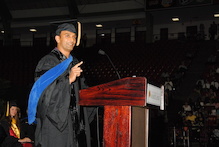Fail Fast to Succeed Early
Throughout high school and part of his college career, DJ Patil, data scientist in residence at Greylock Partners, admits he was a failure at mathematics. It was not until he began tackling his fear of failure that Patil learned how to analyze problems, develop and test solutions, and continue with the testing process until reaching the right answer.
Patil’s ability to “fail fast” was honed during his doctoral studies at Maryland after failing his first graduate class and getting the second lowest score in the class on his first Ph.D. qualifying exam—only because the lowest score belonged to a student who was a no-show for the test. “I made up my mind at that point to stay in the game largely by failing, getting back up, and continuing to push ahead. I learned tenacity and failure go hand in hand,” explains Patil. The sports analogy he offers: Aim for a homerun by going to bat as often as you can.
That mindset was instrumental in Patil’s meteoric rise in the technology industry. The former chief product officer at Color, a video and photo sharing site, he also previously led the Analytics and Data Teams at the LinkedIn Corporation, overseeing all analytics projects including reporting, web analytics, and products that leverage LinkedIn’s unique data set, such as People You May Know and Who’s Viewed My Profile.
“At LinkedIn, we would build products quickly, test them, learn about what went wrong and test again,” explains Patil. “If you looked at all the projects, code, design and time invested in building the company, it is shocking to see how many products did not work.”
Before making the leap to the corporate world, Patil made the transition from a student in the college’s top-ranked applied nonlinear dynamics and chaos group to a respected faculty member helping drive a major research initiative on numerical weather prediction. He then worked as an AAAS Science and Technology Policy Fellow for the Department of Defense, where he directed efforts that leveraged social network analysis and the melding of computational and social sciences to anticipate emerging threats to the United States. He also co-chaired a major review of U.S. efforts to prevent bioweapons proliferation in Central Asia and co-founded the Iraqi Virtual Science Library, which has been hailed as one of Iraq’s most important education projects, helping Iraqi scientists, doctors and engineers rebuild their country.
As he embarks on a new stage of his career working with venture capitalists, Patil continues to view failure as an opportunity to succeed. At the college’s May commencement ceremony, he urged graduates to allow themselves to fail as often and as quickly as they can.
Four Tips For New Graduates
“First and foremost, find your passion and work on what you love. once you find your passion, you will never give up, take no for an answer, or have patience for those that stand in your way.”
“Surround yourself with people you value and those who value you. Keep company with individuals that inspire you to do better and are not afraid to tell you the unvarnished truth. it will hurt to hear, but it will allow you to iterate faster.”
“Experience other people’s lives and continue to share your own. Share your dreams, passions, heartaches and failures with those around you. That is how you learn about the human condition and the meaning of true relationships.”
“Strive to put yourself in uncomfortable situations. the only way to stay on top of the curve is to keep learning. this means putting yourself in uncomfortable situations where you fail and teach yourself new skills as a result.”



